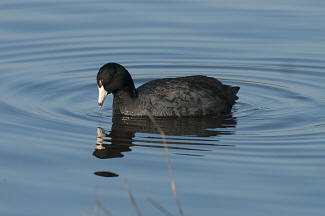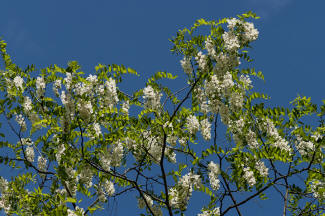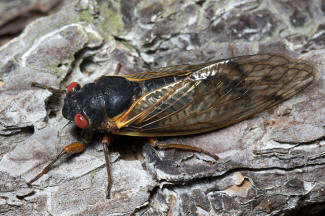PROFILES IN NATURE
American Coot
Photo Credit – www.kentuckyupclose.com
Almost anywhere one goes in this area around water the American
Coot or Fulica Americana is present. They can be easily recognized by a
solid black body with white bill and sometimes a small red spot on their
forehead. Another common name is
Mud Hen.
Although commonly seen
floating around with several species of puddle ducks the coot isn’t
really a duck at all. Coots lack the wide bill and fully webbed feet of
ducks. They have flaps of skin on each toe that help in swimming and
support them on muddy flats. These flaps retract when they lift their
foot though so as not to hinder in walking.
Primarily vegetarian, coots eat a wide variety of aquatic
vegetation including algae. They will also take small insects and
crustaceans. Right at home in the water or on land they are able to dive
for food and are more agile on land than ducks.
After building a nest out of reeds or cattails the hen will lay
anywhere from six to ten eggs. These eggs will hatch in twenty one days
just like a chicken. Although the female does most of the nest building,
the male takes over and does most of the incubation. Sometimes several
nests are constructed before the fussy female decides which one she
wants to lay eggs in. Nests are large floating structures that are
usually well hidden in thick foliage.
Newly hatched chicks are covered on the front half of their body
with orange tipped plumes which may aid in parents recognition of their
own chicks. If these youngsters survive to adulthood they can look
forward to a pretty long life span for a bird. Coots have lived up to
twenty two years in captivity.
Not considered a good food source by most hunters they are not
commonly taken during duck season, at least not locally. In some regions
this is not the case. Some Cajun recipes call for coot to be used in
making gumbo.
By Jack Glisson
Published in The Ballard County Weekly 05/06/2015
PROFILES IN NATURE
Black Locust
Photo Credit – www.kentuckyupclose.com
In full bloom throughout our area now is the Black Locust tree,
or Robinia pseudoacacia.
Today thickets of locust are generally considered to be a
nuisance by farmers but this was not always the case. Called the
“hardest wood in America” timbers from this tree formed the heart of
Jamestown, the first permanent English settlement in American. Due to
its hardness and rot resistance it has been used extensively for fence
post, ship building, and Native Americans crafted bows from it. It has
been suggested that the deciding factor in the war of 1812 was the fact
that American ships were put together with locust pins whereas the
British ships were not which made them more susceptible to cannon fire.
Whether this wood played that important of a role may never be known but
the fact remains that in the following years there was a thriving export
market to the British of locust wood.
Belonging to the legume family locust trees tend to improve the
soil where they grow by fixing the nitrogen. Once they mature they are
very susceptible to disease and insects so are commonly hollowed out by
several species of wood peckers. This time of year the quantity of
blossoms makes it an important source for honey bees making honey.
Black locust blossoms are an excellent food source. They can be eaten raw or combined in salads or even cooked in a variety of dishes. It is possible to eat the seed pods but they must be harvested while still green. As usual though, neither the paper nor my-self are responsible for the mis-identification and possible untoward side effects from eating unknown wild plants.
By Jack Glisson
Published in The Ballard County Weekly 05/13/2015
PROFILES IN NATURE
Periodical Cicada
Photo Credit – www.kentuckyupclose.com
There here!
For the ones of you that have been following my column, I have made
mention at least a couple of times that the Periodical Cicada is due
here again in 2015. I found and captured the first ones on 05/12/2015.
Commonly called “13 or 17 year locust” this
insect isn’t really a locust at all. That would be a grasshopper and we
don’t have the species that cause those swarms here.
Instead, they are cicadas. Periodical cicadas differ from annual
cicadas in that they have a several year life span (either 13 or 17
years) whereas the annual cicada has a lifespan of 2 to 3 years, they
are considered annual because there are always a few that emerge each
year. Periodical cicadas can easily be distinguished from annual
species. They are much smaller and all 7 species have bright red eyes.
The different broods of periodical cicadas are well documented and maps
exist of the years of emergence as well as the areas that will be
affected. What we are seeing this year is Brood # XXIII, the Lower
Mississippi Valley Brood. This is a 13 year cicada.
There are 7 described species of periodical
cicada, 4 thirteen year and 3 seventeen year. All of them are in the
genus Magicicada. The
emergence of brood XXIII this year should be nothing short of
spectacular. This brood contains all 4 of the 13 year species and covers
areas of
AR, IL, IN, KY, LA, MO, MS, and TN.
Cicadas are harmless to humans. They have piercing mouthparts to suck
sap from twigs and an ovipositor to pierce bark and lay eggs, but do not
use these for defense.
After digging an emergence tunnel, mature nymphs will crawl up some
structure and shed their skin, this process is called
ecdysis. Adults
only live for 4 to 6 weeks during which time they call, mate, and lay
eggs. The female makes a slit in a twig and deposits eggs. Around 20
eggs are laid in each slit and individuals may lay up to 600 each! Many
of these twigs later will die beyond the pierced site and dead twig tips
or “flagging” will be evident of many trees in the area. When the young
hatch they are about the size of a small ant and will fall to the ground
and burrow in which is where they will spend the next 13 years before
emerging again in the year 2028! During these 13 years the nymphs will
undergo 5 stages of growth while feeding on sap and juices from plant
roots.
While generally considered harmless, sometimes the sheer numbers of
insects laying eggs may damage young trees. About the only protection
from this would be to cover smaller trees with some type of screening or
netting.
For most of us, just set back and enjoy one of nature’s shows!
Published in The Ballard County Weekly 05/20/2015


